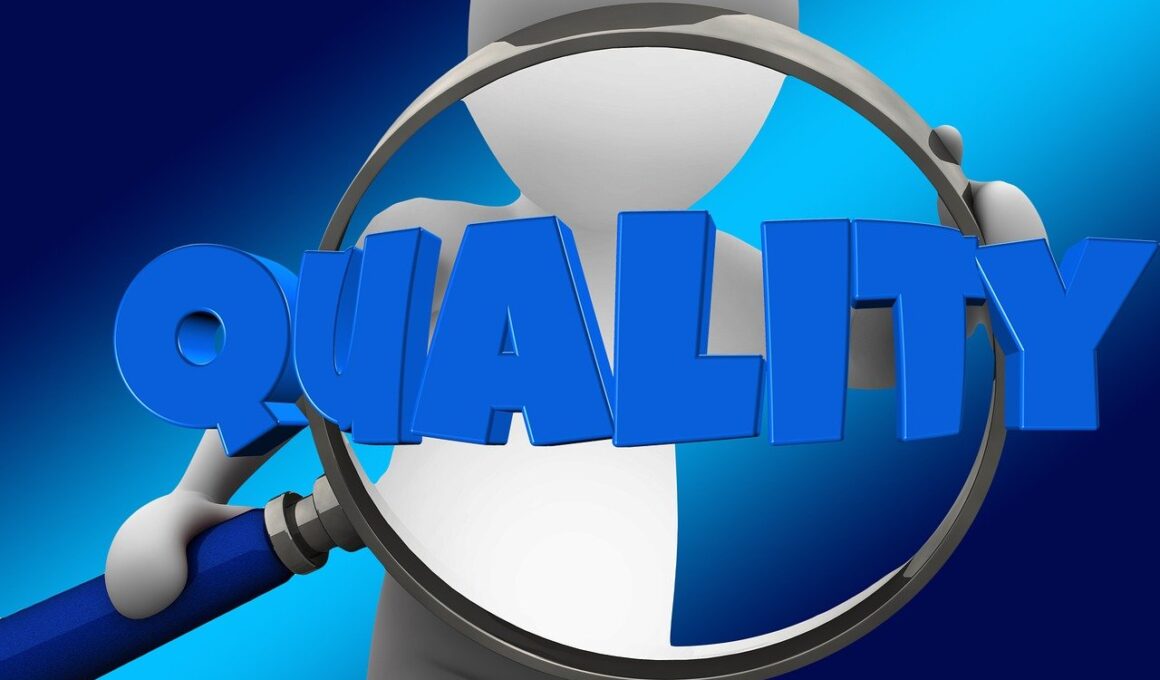Quality Management in Agile Project Environments
Quality management in Agile project environments emphasizes flexibility and responsiveness. Agile methodologies, such as Scrum and Kanban, adopt iterative cycles known as sprints. Each sprint provides teams with opportunities to evaluate and enhance the quality of project deliverables. Traditional quality management often relies on extensive documentation, while Agile thrives on collaboration and feedback. In Agile, quality assurance becomes part of every phase, rather than an end-stage process. This integrated approach ensures that teams do not only wait for the final product to test, but they engage in continuous testing and validation. Effective communication among team members is vital, enabling rapid adjustments based on client feedback. Utilizing automated testing tools further enhances the Agile quality management process. Teams must also focus on user stories that clarify requirements, making it easier to gauge if functionality meets quality standards. It is crucial to foster a culture that promotes quality as everyone’s responsibility. Overall, the Agile framework allows for enhanced adaptability, ensuring that quality is dynamically managed throughout the project’s lifecycle, leading to successful outcomes and satisfied stakeholders.
In Agile methodologies, team roles are clearly defined to promote accountability for quality outcomes. Each member contributes to the quality management process, thus enhancing collaboration and transparency. Individuals like the Scrum Master and Product Owner play pivotal roles in ensuring that quality standards are upheld and understood. The Scrum Master’s responsibility includes facilitating Agile ceremonies that integrate quality discussions. For instance, during daily stand-ups, teams address issues that may be hindering quality. The Product Owner ensures that the backlog items are well-defined and prioritized, reflecting the quality requirements of the stakeholders. Emphasizing the importance of quality over quantity enables teams to maintain focus on delivering value rather than merely pushing productivity. Regular sprint reviews also provide an opportunity to assess deliverables against quality metrics, allowing for immediate rectifications. Agile environments encourage a proactive approach to quality, where feedback loops ensure that end-user satisfaction is a priority. Teams can employ various metrics such as defect density and customer feedback scores to measure quality continually. Such practices collectively create a robust framework for ensuring quality prevails across Agile projects, thus fostering credibility in project delivery.
Integrating Quality Assurance into Agile Practices
Integrating quality assurance into Agile practices requires a mindset shift throughout the organization. Rather than treating quality as a separate function, it should be embedded within the development process. This integration manifests through practices which include continuous integration and automated testing. Continuous integration encourages developers to submit their code frequently, ensuring that issues are detected and resolved early. Automated testing complements this by allowing for repetitive test operations, thus saving time while maintaining consistency. These practices collectively contribute to maintaining quality without sacrificing speed. Agile teams should adopt a quality-first mindset, where every member accepts responsibility for maintaining quality communication throughout all project stages. Emphasizing the importance of regular feedback from both users and stakeholders allows teams to adapt and refine quality metrics continuously. Another essential aspect of integrating quality assurance is to establish clear definitions of done. These ensure that everyone has the same understanding of the requirements for each task. Adopting these strategies paves the way for a quality-centric culture within Agile environments, ultimately supporting the project’s overall goals and objectives.
Documentation in Agile is often less comprehensive than in traditional projects, yet its significance should not be underestimated. Agile teams should ensure that their documentation complements their quality assurance efforts without becoming overly burdensome. Effective documentation helps clarify processes, roles, and procedures related to quality, making it easier for team members to adhere to best practices and standards. Some teams use lightweight documentation strategies like user stories and acceptance criteria to maintain clarity while ensuring quality. Utilizing tools like wikis and shared drives for documenting lessons learned maintains a culture of continuous improvement and quality enhancement. It is essential that Agile teams engage in regular retrospectives, allowing them to reflect on past iterations and enhance quality in future sprints. Additionally, encouraging peer review within the development process fosters a culture of proactive quality assurance, as colleagues can quickly identify potential issues or areas for improvement. Agile promotes transparency and accountability, so reflecting on and documenting quality-related challenges helps teams innovate and optimize workflows. By customizing documentation approaches while fostering collaboration, Agile teams can successfully reinforce their commitment to quality management across their projects.
Tools and Techniques for Agile Quality Management
The successful implementation of quality management in Agile requires specific tools and techniques tailored to the Agile methodology. These tools help visualize progress, facilitate communication, and ensure testing is synchronized with development. Agile project management tools like JIRA, Trello, and Asana offer functionalities to manage product backlogs effectively, allowing teams to prioritize tasks while keeping quality in focus. Automated testing tools such as Selenium and JUnit play essential roles by enabling continuous testing and rapid feedback cycles. Additionally, tools for version control like Git facilitate collaborative development and quality tracking, integral to any Agile environment. Role-specific tools permit team members to streamline their focus on quality-related tasks, thus improving overall workflow efficiency. Scrum boards can be instrumental in visualizing tasks, allowing the team to see which segments are completed and which require attention. Regularly using these tools ensures quality remains a focal point throughout the entire development process. Teams must evolve their use of these technologies as project demands change, exhibiting a commitment to quality that adapts and grows with Agile practices.
In Agile, client involvement is a cornerstone of effective quality management. Actively engaging clients ensures alignment between project deliverables and user expectations, promoting transparency. Frequent feedback loops allow Agile teams to access valuable insights, helping them refine their products continuously. Daily interactions or sprint reviews facilitate open discussions, allowing clients to provide feedback on completed work. Such interactions help teams make necessary adjustments quickly, ensuring overall product quality meets the required standards. Furthermore, customer involvement creates a sense of ownership, enticing stakeholders to invest more in the process. It reinforces the Agile principle of customer collaboration over contract negotiation, significantly enhancing quality. Agile teams also consider user experience during product development, maintaining a user-centered approach that drives quality improvements. By incorporating design thinking methodologies, teams can explore user needs and behaviors, ensuring deliverables align with expectations. Ultimately, engaging clients throughout the project lifecycle fosters a holistic understanding of quality requirements while enhancing stakeholder satisfaction, making it a central pillar of Agile project success.
Continuous Improvement Process
Continuous improvement is a fundamental principle within Agile methodologies, enhancing quality management across projects. Agile teams should adopt frameworks like Plan-Do-Check-Act (PDCA) to promote their commitment to quality. This iterative cycle encourages teams to plan quality initiatives, execute them effectively, review outcomes, and make necessary adjustments based on feedback. Conducting regular retrospectives validates this process, allowing teams to self-assess and explore areas for enhancement. Identifying roadblocks or inefficiencies prompts teams to propose actionable solutions, fostering empowerment and ownership over the quality management process. Furthermore, utilizing metrics to measure quality performance, such as customer satisfaction and defect rates, provides concrete data to guide improvement efforts. Agile teams can create action plans based on quantitative and qualitative insights that drive results. Training sessions or workshops focused on quality best practices can also facilitate continuous learning. Embracing a culture of experimentation encourages teams to test innovative approaches aimed at enhancing quality. Ultimately, fostering continuous improvement creates an environment where Agile teams thrive within a robust framework of quality management, leading to successful project outcomes and satisfied stakeholders.
Successful quality management in Agile projects relies on stakeholder engagement. Stakeholder involvement helps ensure that the project meets their expectations, thus enhancing quality outcomes. Teams must actively communicate with stakeholders to gather insights and feedback. This process entails more than just presenting completed work; it involves fostering genuine dialogues surrounding the project’s vision and goals. Stakeholders bring valuable perspectives that help shape the quality standards and requirements. Incorporating their input early in the project’s lifecycle mitigates the risk of costly late-stage revisions. Facilitating collaboration among stakeholders encourages ownership while reinforcing accountability within the Agile team. Furthermore, Agile teams should prioritize stakeholder feedback during retrospectives, integrating it into their continuous improvement processes. The partnership formed between stakeholders and the Agile team sets the tone for embracing quality as a shared responsibility. Cultivating relationships allows teams to navigate challenges more efficiently, ensuring alignment among all parties involved. Agile quality management thrives when built on strong interpersonal connections with stakeholders, reinforcing the overall project goals and nurturing a successful delivery process that prioritizes quality outcomes.


